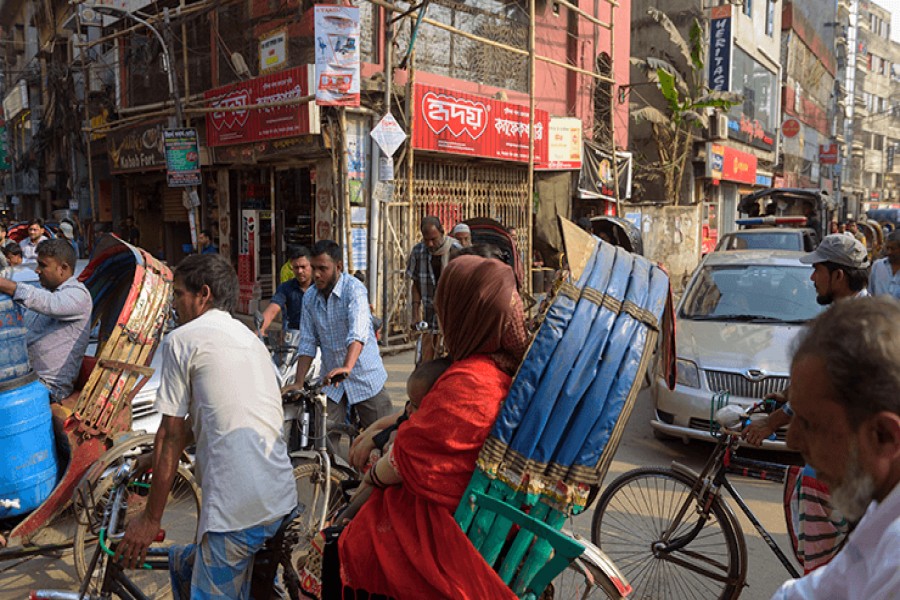
Published :
Updated :

There was a time when the urban middle class ruled the state or was about to be born. Never mind if people were not sure what it meant or how they were defined. The urban middle class was basically understood as a socio-economic category who stood guard over the national "spirit" whatever that meant as well. It was this vagueness that gave them power and the cultural space in the urban zones which they occupied and was their greatest signal of legitimacy.
This period was between 1947 and 1971 when Bangladesh- about to be - was being played out. However, the war changed that as political power was re-formed and several new entrants made the scene. This included the army who were capable of taking over state power and did. Nor did people bother to read long editorials and poetry to decide what to do next weakening the middle class clout.
As socio-economic changes took place and bank loans gave birth to a new class who didn't need to listen to sermons, the middle class expanded in numbers but more a matter of population size while its moral force began to dwindle. In the post-middle class moral society, they faced a battle to be recognized and accepted as they were as the imagined descendants of Ekushey.
But while the middle class grew in size its clout dimmed proportionately. The middle class -by that one means the urban middle class- doesn't fully understand the process of this disempowerment. One reason is their continuous faith in the power of the State as the agency of intervention doesn't go with the clout of the same institution. They pin a lot of hope in elections which are entirely weakened as an institution by politicians themselves.
It means the State exists but in a highly reduced state manned by a variety of players with an institutional identity which is closer to a private company with several large scale exclusive monopoly business contracts. It can't and is not interested in doing anything unless there is profit attached to it by whatever name it's called. But most importantly, this is also where the urban middle class and their clan lives.
Population size matters but transition matters more. Economists estimate that the size of the "middle class could well be around 44 million and 60 million in 2025 and 2030, respectively." This obviously means that such a large number of people need to be looked after. The suggestion therefore is, " to take full advantage of the dynamics behind the expansion of the middle-class, Bangladesh should design policies that are consistent with the needs of the heterogeneous middle-class households and increase their resilience."
The problem in such solutions which are possible and practical is the inevitable choice of agency, the government in initiating policies. Actions to strengthen the middle class particularly the upper middle class is very important and obviously state policies need to be key.
But the concept that serves as the root of many positive economic governance ideas is a construct that is free of self service based decision making and has the ability to implement such policies after formulating them. And that is where the key question is.
The middle class can be split widely into the urban and rural version. The discussion by most experts is more about the economic structures, behavior and potential of the traditional urban middle class. It follows conventional and logical economic and policy behavior. However, in the case of Bangladesh, what is understood as governance is itself different and more complex but at the same time limited.
It means, the official policy making world is actually aware that their policies have very limited reach and doesn't apply to a majority of the economic realities including of the overall middle class. Today the majority lives in the rural areas not the urban zones where the State is virtually non-existent. The middle that we think of, the traditional shushil middle, is a graduated one who is trying to go to the upper section using the government where the economic opportunities are as wide as any entrepreneurship zone.
The new middle classes and external economies are the new reality. Field level research data shows significant changes beyond the pale and policies of the government and a distinct lack of dependence on the formal economic structure. A major part of that is of course migration but internal and external migration itself is driven by the economic status of the intending migrant so the very poor use internal sources of employment for poverty alleviation. It doesn't produce a significant (powerful) lower middle class located both in rural societies as well as having a footprint in the urban domain. But their self-management of poverty alleviation is not a product of government policy but more out of response to economic needs.
Meanwhile, the upper middle class is being produced by external migration with several economic layers within. The majority goes to the Middle East but many go to Malaysia too with a significant rural upper middle also going to Europe and all are able to mobilize several lakhs to fund the process. In fact rural economies have structured this process as an economic activity as an instigator of economic change.
While agriculture is still a major part of the employment sector, external migration consumes almost 25 million people. That makes them a significant chunk of the labour market generally held to be around 75 million including those over 15 years. The agro and industrial labour population will not produce the consuming middle class but the external migrants will. And this high growth is not a result of any government policy.
Which is why who is and how the new middle class is doing needs more attention as a left out sector of socio-economic change.


 For all latest news, follow The Financial Express Google News channel.
For all latest news, follow The Financial Express Google News channel.